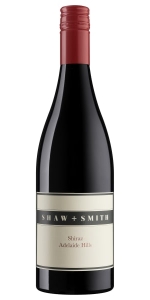Wine from Shaw and Smith
Shaw + Smith was established in 1989 by cousins Michael Hill Smith MW and Martin Shaw. They make wines exclusively from the Adelaide Hills, from varieties that suit the cooler climate: Sauvignon Blanc, Riesling, Chardonnay, Pinot Noir and Shiraz. Shaw + Smith own two vineyards, in Lenswood and Balhannah. Balhannah is also home to the winery where the Tasting Room is open daily.
Growing the best possible grapes, managing vineyards sustainably, and valuing vine health, soil health, and low yields are central to the Shaw + Smith approach. In the pursuit of quality the wines are fermented, aged and bottled on site at Balhannah. The wines are vibrant, medium bodied expressions of their varieties that reflect their sites and region.
Shaw + Smith’s first vintage was in 1990, and the early vintages were made at Wirra Wirra and Petaluma. In 1999 they purchased a property at Balhannah, where they planted vines, and built the winery and tasting room in time for the 2000 vintage. In 2012 they purchased an established 20 hectare vineyard in Lenswood. As the business has grown Michael and Martin have built a formidable team to continue the evolution of Shaw + Smith, including Master of Wine David LeMire, Senior Winemaker Adam Wadewitz, Business Manager Grant Lovelock and Group Viticulturist Murray Leake.
First vinified in 2002, Shaw + Smith Shiraz has quickly garnered attention a standout cool climate Austrlian shiraz.
Sourcing immaculate fruit from the cool Adelaide Hills region, Shaw + Smith carry out whole berry fermentation in open-topped steel vats allowing for gentle yet thorough extraction and optimal aromatics. Maturation in French oak allows tannins to soften and aromas to harmonize before bottling under screw cap.
Shaw + Smith own two vineyards in the Adelaide Hills, at Balhannah and Lenswood, totalling 55 hectares. The vineyards are planted to varieties that perform particularly well in the region, namely Sauvignon Blanc, Chardonnay, Pinot Noir, and Shiraz.
Hand picked, sorted and fermented as a combination of whole berries and whole bunches in open fermenters, with gentle plunging and minimal working. Aged in French oak for fourteen months, of which one third was new.
Shaw + Smith Shiraz is a medium bodied cool-climate Shiraz, in which balance is more important than power.
Decant and enjoy with slow cooked lamb shoulder.
Review:
Lovely crunchy fruit to this, with spice and dried-meat undertones through the wine, from the nose to the palate. Medium body, fine tannins and a fresh and vivid finish. Tangy and bright. Drink or hold. Screw cap.
-James Suckling 94 Points
- back
Selected Options
Wineries
Categories
Pricing
Countries
Regions
Grape Types
Wineries
Organic/Free Shipping
W & J Graham's Vintage Port is made from 35% Touriga Nacional, 47% Touriga Franca and various others.
It is with great pleasure that Graham's announces the declaration of the 2000 Vintage, a wine that has been deemed to meet our very exacting standards, and one that shows every promise of living up to the reputation of the very best Vintage ports that the Twentieth Century provided.
This is a landmark wine for Graham's, not only being the first Vintage of a new millennium, but being the first Vintage wine to enjoy the extraordinary results achieved by the new robotic 'lagares' at Malvedos in the inaugural year of our remodelled winery. Significant also has been the decision to include a rather larger proportion of mature Touriga Francesa and Touriga Nacional from Vila Velha, a classic riverside Quinta a short distance downstream from Malvedos, and some spectacular old vine lots from Vale de Malhadas in the Upper Douro. These wines each from family-owned Quintas have been used to reinforce the predominant component from Malvedos and the traditional excellence of the Rio Torto lots from Lages, to produce a rounded and even blend in the hallmark rich Graham style.
Picking began at Malvedos on September 22nd and the last lagar was run off on October 10th, an unusually short and compact Vintage. Fruit arrived in good condition although yields were less than three quarters of a kilogram per vine, and the juice to skin ratio well below normal. 2000 was a year noted for a very low average yield across the Douro, and with the grapes unusually lacking in liquid, the extra amount of treading work required made it an ideal time to employ our new, tireless, mechanical treaders alongside the two original 1890 stone lagares still worked by human feet. It was evident early on in the Vintage from the colour and aroma of the fermenting musts that we were looking at a spectacular year, and after the usual waiting period of sixteen months or so to see how the lots would develop, we have now made our final selection and assembled the final blend.
The blend displays many of the typical Graham aromas of ripe plum and 'esteva' (gum cistus) and is pleasantly smooth on the palate despite its youth. It is full and rich in the mouth with fresh blackberry and red plum notes. Despite the hallmark Graham sweetness in the mouth the finish is long and clean.
As with all Graham Vintages, this is a wine made to last for years and the patience of laying down the wine for fifteen to twenty years will certainly be rewarded.
Review:
Chavy-Chouet Bourgogne Blanc Femelottes is made form 100 percent Chardonnay.
This is a charming, rich, focused and delightful white. Medium-bodied with a smooth texture, the wine has a fresh backbone of acidity, clean apple and citrus flavors, and an excellent balance. A most refreshing quaff and one that is great value. A delicate, expressive wine of exceptional quality.
The grapes from this wine are grown from the Puligny-Montrachet area. (either outside of the AOC limit or with younger vines).
The grapes from this wine are grown from the Puligny-Montrachet area. (either outside of the AOC limit or with younger vines).
Aged 10 months in oak barrels (10% new, the rest in 2-3 year old barrels).





